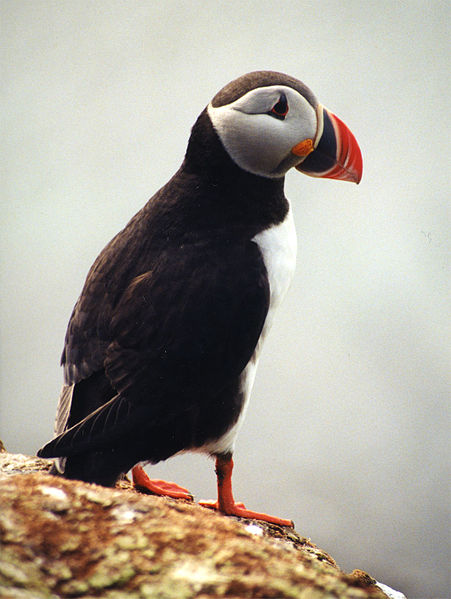
Atlantic puffin: photo credit Hanno
After three hours and two boats rides, Matinicus Rock and Lighthouse that would become my home for the next few weeks, finally appeared in the distance. David, a bird keeper from Omaha's Henry Doorly Zoo, and I were rowed ashore with dry bags heavy with food and supplies. The island supervisors, Caroline and Nathan, came down to meet us at the boat ramp along with Alex, another biologist from the National Aquarium in Baltimore who had already been on the island for a week. Everyone grabbed a bag and we headed up to the house. Once at the house we got settled in the surprisingly comfortable living quarters. I even had my own bedroom.

My lighthouse bedroom
Alex gave us a tour of the area, highlights of which were a climb to the top of the light tower, the composting toilet with view of puffins and an introduction to Moe, the island's very own ghost who calls the decommissioned second light tower his home.

"Moe's lighthouse"
In addition to Atlantic puffins, Matinicus Rock is also home to common and Arctic terns, razorbills, Leach's storm petrels, black guillemots, laughing gulls, common eiders and even a few Manx shearwaters--the only known colony in the United States. Project Puffin monitors the health and population numbers of all the species on the island, and our first major task was to find and band 200 Arctic tern chicks before they completely fledged and figured out that they could just fly away from us. Arctic terns are delicate looking at first glance, but don't let them fool you, these are some tough seabirds. Arctic terns migrate over 20,000 miles from Antarctica every year!

Arctic tern
Their chicks hide in the vegetation as a way to protect themselves from all the hungry gulls flying above, so you really had to search every blade of grass.

Can you find the tern chick hiding in the grass?
Once you found one big enough to be banded you put a flag down where the chick was hiding, to make sure that you returned it to its proper home when you were done. All the while the Arctic tern parents were zooming about, dive bombing our heads and angrily yelling at us for getting to close to their nests, sounding like the machine gun noises you would make as a kid playing cops and robbers.
When it wasn't being used to mark a nest, I stuck my flag in the back of my hat so that the terns attacked it instead of my head! Band-able chicks were brought back to the house where they were weighed, measured and given bands on each leg--a metal field readable and a service band issued by the U.S. government--before being returned to their nest sites. The chick in the photo below didn't know quite what to make of being put on his back.

photo credit: David Vonk
Once we had found all the "obvious" chicks we took turns climbing to the top of the lighthouse and spotting the chicks as they ran out to be fed by their parents and then radioing their location to someone on the ground. Alex spotted this chick as it ran out from under a rock to be fed by its parents and radioed the location to me.

After 6 hours we had banded over 100 Arctic tern chicks! The following day we spent a few more hours searching the grass for more chicks to band and by the end of the week we had reached our goal of 200. Unfortunately for the tern fledgers, just because we've given them their "grown up" bands doesn't mean they'll make it back to the island next year. Perfecting the art of flight takes some time and with hungry gulls searching the skies for their next meal it can be down right dangerous.
Gulls are a natural predator of many seabirds but over the years the gull populations have exploded, changing the natural balance of predator to prey. Gulls are intelligent, opportunistic predators that will try a wide variety of food options, and our landfills and dumpsters have provided them with a never ending food source. Terns, puffins and many other seabirds however, stick to only one food item: fish. So while gull numbers are multiplying as they thrive off of our wasteful habits, most seabirds colonies are shrinking due to overfishing and changes in fish populations in the worlds oceans. More gulls hunting in the already smaller tern colonies means fewer tern chicks and fledgers will survive to adulthood and return to the colony to breed in the future. Of course, gulls are not to blame for finding a way to survive in this new environment we have created, but this certainly is a reminder that something as simple as feeding your leftover chips to the gull hanging out in the park can impact the delicate balance of nature and predator/prey relationships.
Check back soon for more updates from Matinicus Rock!
-Caitlin
Earlier this summer, Caitlin taught us the difference between puffins and penguins, like the ones in our exhibits. Get the scoop in this earlier blog post!
I recognize that bedroom! spent a very happy 2 weeks in it 5 years ago. Did you have any hauntings from the resident ghosts?? :) -Kate Banks
ReplyDelete